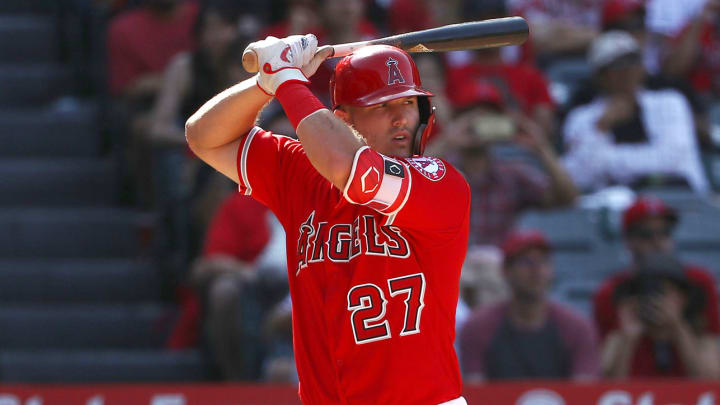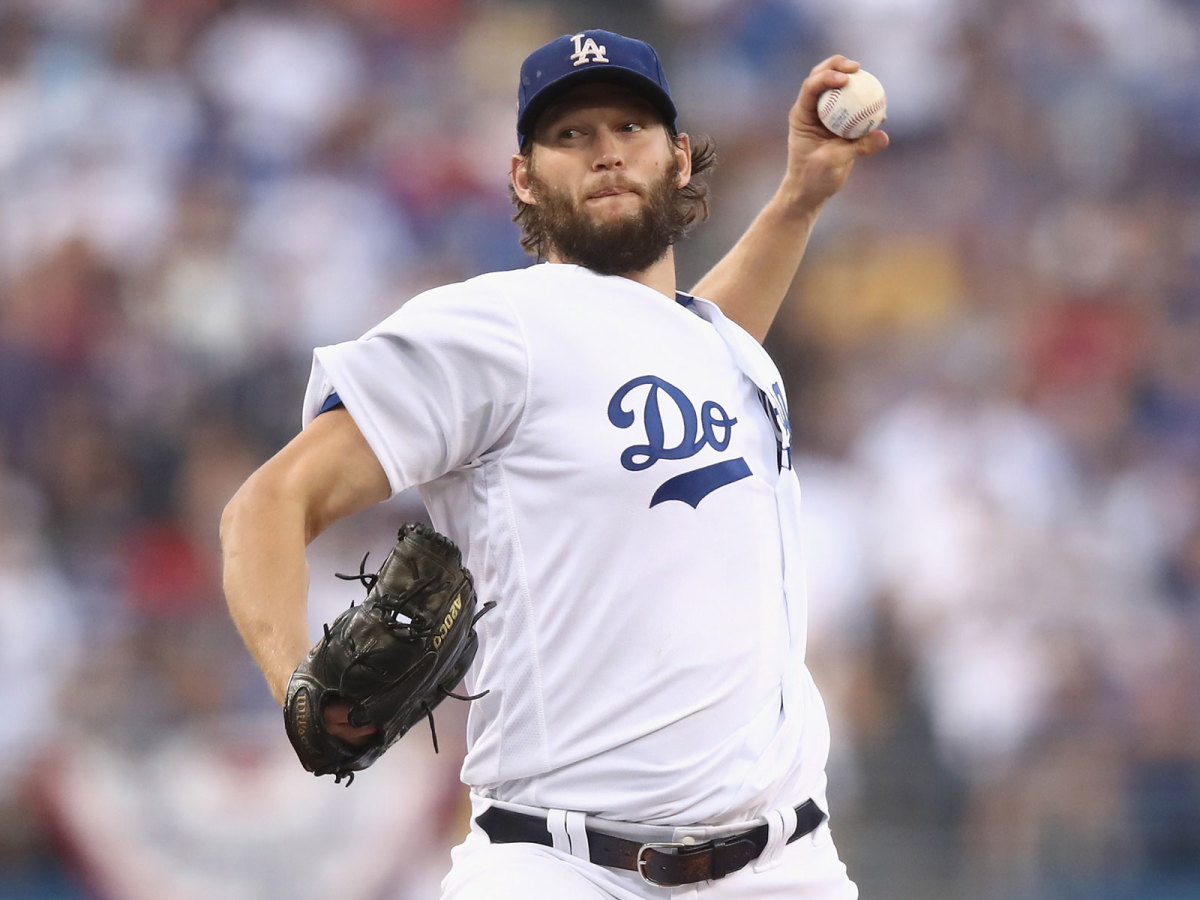How the Angels Plan on Finally Making Use of Mike Trout; More Spring Training News and Notes

TEMPE, Ariz. — The Los Angeles Angels are wasting the greatness of Mike Trout. It’s not just that they are one of only seven teams not to win a playoff game since Trout debuted in 2011. It’s also because they have not supported him with players who get on base in front of him.
New Angels manager Brad Ausmus faces the same riddles that vexed his predecessor, Mike Scioscia: where should Trout hit? And can anybody on the roster get on base consistently in front of him?
Last year the Los Angeles analytics department recommended Trout hit in the second spot. It makes sense in a vacuum. Each spot in the lineup is worth about 18 plate appearances per year (so hitting second would give a hitter 36 more turns at bat than cleanup, for example). But because the Angels were so bad at getting hitters on in front of Trout—historically bad—Scioscia moved Trout to third in the second half of the season.
Scioscia told me then his logic went like this: sure, it’s great to get more plate appearances, but getting more plate appearances with runners on is the higher goal.
Ausmus hasn’t committed to a batting order yet. He batted Trout leadoff in his first spring game, Sunday. Don’t read anything into it.
“Just to get me at-bats before I come out,” Trout said.
For his part, Trout doesn’t care much where he hits. But he did acknowledge that higher leverage spots make it more difficult for pitchers to pitch around hitters.
“No doubt, there’s a difference for any hitter with runners on rather than bases empty,” he said.
What happened to Trout last year was an all-time waste of a season. Trout posted the 250th season in baseball history with a .600 slugging percentage over 600 or more plate appearances. That is massive slugging over a big sample. And yet Trout’s 79 RBI ranked 250th out of those 250 seasons—dead last.
And, no, it wasn’t because he wasn’t clutch. Trout hit .346 with runners in scoring position. Take away his 39 homers, and because he had so few opportunities Trout drove in only 40 runners from the bases all year—fewer than Daniel Descalso or Miguel Rojas.
Something just isn’t right about the best player in baseball getting so few opportunities. What went wrong? It’s easy to see. Check out where the Angels ranked in the American League in the three batting order positions that preceded Trout’s usual No. 2 slot:
Angels' League OBP Rank By Batting Order Spots
Batting Position | OBP | AL Rank |
|---|---|---|
Eighth | .251 | Last |
Ninth | .279 | Tied 7th |
First | .295 | Last |
Los Angeles did not get even a .300 OBP from any of the three spots in front of Trout. The leadoff spot was particularly atrocious. (Only the Giants were worse in MLB.) Scioscia mostly filled it with veterans having bad years: Kole Calhoun, 30, (64 starts), Ian Kinsler, 36, (53) and Zack Cozart, 32, (26).
The average AL hitter, regardless of batting order spot, takes 57% of his plate appearances with the bases empty. Trout came up with nobody on 62% of the time. Virtually two out of every three times up Trout batted with the bases empty. This is the equivalent of not giving LeBron James touches or having Tom Brady run the wishbone.
The lack of support cost him 30 chances to hit with runners on compared to the average hitter, and 49 such high leverage chances compared to Andrew Benintendi, the primary No. 2 hitter for the deep Boston lineup.
Check this out: a comparison of Trout’s “empty” plate appearances to the primary No. 2 hitters for the best teams in the league: Alex Bregman of Houston, Michael Brantley of Cleveland, Aaron Judge of the Yankees, and Benintendi of the Red Sox:
Player | Bases Empty | With Runners On | Pct. of "empty" At-bats |
|---|---|---|---|
Mike Trout | 377 | 231 | 62% |
Alex Bregman | 413 | 292 | 59% |
Michael Brantley | 366 | 265 | 58% |
Aaron Judge | 278 | 220 | 56% |
Andrew Benintendi | 360 | 301 | 54% |
Now back to what Trout said about how pitchers work hitters differently whether runners are on base. True to his instincts, pitchers threw Trout fewer pitches in the strike zone when they faced him with nobody on base. The difference in how they pitch him is even starker when you look at fastballs in the strike zone:
Trout: Pitches Seen in Strike Zone by Situation
Situation | Total Pitches | Strikes | Strike PCT. | Fastball Strikes | Strike PCT. |
|---|---|---|---|---|---|
Bases Empty | 1,675 | 813 | 48.5% | 517 | 30.9% |
With Runners | 868 | 432 | 49.8% | 291 | 33.5% |
It’s a fact: getting runners on in front of Trout leads to Trout seeing more fastballs in the strike zone. Why is that important? Here is your answer:
Highest Slugging Percentage on Fastballs in Zone, 2015-18 (Min. 750 results)
Player | Slugging PerCenTage |
|---|---|
1. J.D. Martinez | .773 |
2. Nolan Arenado | .732 |
3. Khris Davis | .726 |
4. Mike Trout | .700 |
So now what do you do if you are Ausmus? (His four Detroit teams ranked ninth, ninth, fourth and 11th in leadoff OBP in the AL.) He could try David Fletcher, assuming Fletcher nails down the everyday job at second base. Fletcher, 24, posted a .345 OBP in the minors and .316 in 80 games with the Angels last year.
Cozart has a career OBP of .304, and outside of his anomalous 2017 season, does not profile as a leadoff hitter. Calhoun needs to regain his stroke and confidence, which went missing in the first half when he failed in his attempt to join The Launch Angle Revolution. (He did show a mid-season bounceback, but cratered in September.) Andrelton Simmons, while an improved offensive player, has started only 13 games over the past five years in the leadoff spot because he’s such an aggressive swinger.
The Angels’ best bet might be to borrow from Alex Cora’s 2018 Red Sox team and play Shohei Ohtani in the role of Mookie Betts: a leadoff hitter who pressures the pitcher from the very first pitch of the game. Imagine having to work Ohtani-Trout-Justin Upton right out of the gate—or in the ninth inning when the lineup turns over.
In any case, this is not just a problem for Ausmus, it’s a problem for all baseball fans. It’s bad enough that we don’t get to see Trout in the postseason. But watching him take almost two-thirds of his at-bats with the bases empty is a waste of a generational talent.
Time will tell, but for now the Cubs appear genuinely refocused (especially when it comes to leadership from key players) after losing nine times with zero or one runs scored in their final 26 games, including their division tiebreaker and Wild Card defeats.
It wasn’t a 2011 Red Sox collapse, but more of a slow fade that doomed Chicago—and maybe it was the roof in Milwaukee that helped decide the NL Central. Guaranteed home games kept the Brewers on a routine schedule. They had off every Thursday in September as they closed out the Cubs on a 20-6 run. The Cubs, meanwhile, because of dodgy weather, went to the ballpark 42 times in the final 43 days. On their only true off day they landed in Chicago from Arizona at 5:30 a.m.
But don’t shortchange Milwaukee. Even with the more routine schedule, the Brewers won the division the old fashioned way: they earned it by going 5-2 against the Cubs down the stretch.

• Need another sign that increased velocity is changing the game? Now it’s affecting manufacturing. MLB is using new batting helmets this year. These ones are built to withstand fastballs up to 105 mph. The old ones were rated up to 100 mph. Last year there were 1,320 pitches thrown at 100 mph or greater. Eight of them hit a batter. A.J. Pollock gets the prize for the highest velocity hit by a pitch: a 104.3 mph heater from Jordan Hicks that struck his left forearm.
• When I watched Clayton Kershaw throw his first live BP session two things stood out: he bounced a lot of curveballs, and when he was done he headed to the bullpen for another mound session. It struck me as oddly early in the spring to be logging that kind of workload, but Kershaw is a grinder. It was after his next bullpen session that he complained that his shoulder didn’t feel right. The Dodgers will monitor him closely and give him all the time that he needs to get right, without the artificial deadline of trying to get ready for Opening Day.
• Meanwhile, the club is thrilled with the early showing of Julio Urias. The 22-year-old lefty topped out at 96.8 mph last year when he came back from shoulder surgery, and he looks to be throwing even harder after a normal offseason of training. Los Angeles won’t let him make 30 starts this year, but Urias could be an impact pitcher for 15-20 starts.
• The Rangers are bringing along slowly two-way player Matt Davidson when it comes to his pitching. They won’t begin to ramp up his mound work until the latter half of spring training just to ease the physical toll on his body. Davidson is a legit pitching threat. It’s not just that he can throw in the low 90s. He also has a curveball that manager Chris Woodward said has the metrics of an above-average breaking ball. Last year Davidson threw 13 curveballs measured at a spin rate of 2,373 rpms—faster spin than the curveball of Jose Berrios.
• The Cubs are encouraged about a mechanical fix made by Tyler Chatwood. The righthander always pitched with a slight tap of the ball in and out of his glove, but last year he developed a habit of stabbing the ball away from him after the tapping trigger. Chatwood has cleaned up the stabbing motion. Still, the test for Chatwood will be how he holds up in the heat of competition. Last year, when the game seemed to speed up on him, Chatwood threw only 44% of his pitches in the strike zone.
• It’s hard to stand out in a hitting group with Trout and Albert Pujols, but Angels prospect Jo Adell, who turns 20 in April, does just that in batting practice. Adell has played only 17 games above A ball, but he could force his way into the majors at some point this year.
• Here’s one player’s reaction to Aaron Hicks taking a seven-year, $70 million contract from the Yankees when he was one season away from free agency at age 30: “Not good for players, man.” It’s another case of how the decline of free agency is discouraging players from betting on themselves. The length seems more about New York amortizing its luxury tax cost over a seven-year period. Hicks, who ranks behind only Trout and Lorenzo Cain in WAR for centerfielders the past two years, sold his free agent years at a lower cost ($10.67 million AAV) than those of Odubel Herrera ($11.33 million), A.J. Pollock ($13.75 million) and Dexter Fowler ($16.5 million). The good news for Hicks: he found a home in New York and is locked up through his age 35 season, a rarity in recent deals.
